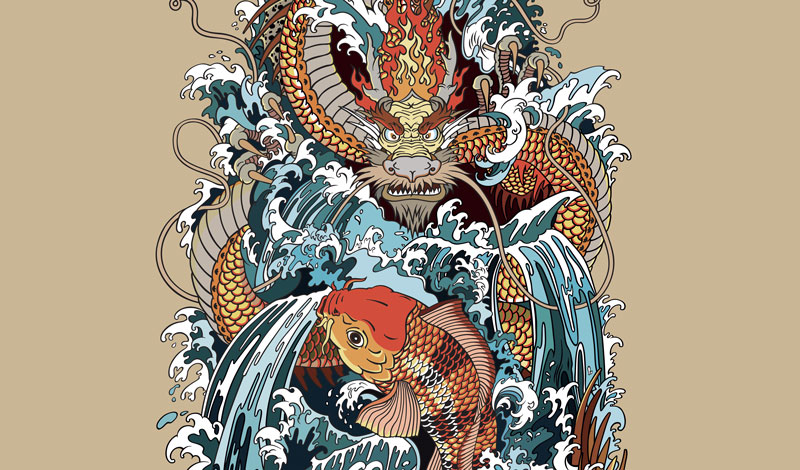A waterfall called the Dragon Gate exists in China. Its waters plunge a hundred feet, swifter than an arrow shot by a strong warrior. It is said that a great many carp gather in the basin below, hoping to climb the falls, and that any that succeeds will turn into a dragon. Not a single carp, however, out of a hundred, a thousand, or even ten thousand, can climb the falls, not even after ten or twenty years. Some are swept away by the strong currents, some fall prey to eagles, hawks, kites, and owls, and others are netted, scooped up, or even shot with arrows by fishermen who line both banks of the falls ten cho wide. Such is the difficulty a carp faces in becoming a dragon. …
Attaining Buddhahood is no easier than for men of low status to enter court circles, or for carp to climb the Dragon Gate. …
My wish is that all my disciples make a great vow. (“The Dragon Gate,” The Writings of Nichiren Daishonin, vol. 1, pp. 1002–03)
Nichiren Daishonin wrote this letter on Nov. 6, 1279, to Nanjo Tokimitsu, his youthful disciple, at the height of the Atsuhara Persecution. From around 1275, Nichiren’s followers faced growing acts of intimidation and violence in Atsuhara Village at the hands of feudal authorities, culminating in the imprisonment and torture of 20 farmers who refused to yield their faith.
Three of the farmer disciples, Jinshiro, Yagoro and Yarokuro, were beheaded, and the remaining 17 banished from their village. Nichiren was deeply moved by the unyielding devotion of these ordinary men who had neither education nor social power. Their martyrdom represented the emergence of ordinary people who, beyond being mere believers, strove alongside the Daishonin to realize kosen-rufu. This marked both the fulfillment of Nichiren’s advent in the world and the establishment of the people’s Buddhism.
Ikeda Sensei writes of this: “Precisely because his followers were undergoing a period of intense, life-threatening persecution by the ruling authorities, the Daishonin taught Tokimitsu the unflinching attitude in faith that the times demanded. He explains in stark terms just how exacting the path to attaining Buddhahood is. The fact that he does so is perhaps also an indication of his profound trust and high aspirations for his young disciple” (Learning From the Writings: The Hope-filled Teachings of Nichiren Daishonin, p. 123).
Tokimitsu was just 21 years old at the time of this letter, and, though young, he valiantly strove to protect other believers facing persecution from feudal authorities, while at the same time facing threats himself, including heavy taxes.
In this letter, the Daishonin uses the analogy of the Dragon Gate waterfall in ancient China to convey that one must surmount incredible challenges to attain Buddhahood. And he makes an ardent appeal to Tokimitsu to arouse a great vow for kosen-rufu and carry on his struggle, proclaiming: “My wish is that all my disciples make a great vow” (WND-1, 1003).
In this issue, the World Tribune gleans several points from Sensei’s lecture on “The Dragon Gate,” about how making a vow for kosen-rufu and deepening our mentor-disciple bond are the keys to withstanding any adversity.
—Prepared by the World Tribune staff
Ikeda Sensei
1. The mentor-disciple bond can withstand any adversity.
Some sources place the legendary Dragon Gate on the upper or middle reaches of the Yellow River. It was held that carp that managed to climb the falls would become dragons. …
Through this example, Nichiren highlights for Tokimitsu that remaining steadfast in one’s Buddhist practice to the very end is an undertaking fraught with as many difficulties as a carp faces in climbing the Dragon Gate and turning into a dragon. The strong currents of the waterfall that drive the fish back can be likened to the conditions of an evil age defiled by the five impurities as described in the Lotus Sutra; while the birds of prey and fishermen can be likened to the three obstacles and four devils and the three powerful enemies that hinder one’s efforts to attain Buddhahood.
Persevering in faith in the evil age of the Latter Day of the Law is like swimming upstream against a powerful current. It is hard enough just to resist the insidious forces exerted by our own earthly desires and fundamental darkness. …
Precisely because it is so difficult to carry out faith in the Mystic Law in such an age, the bond of mentor and disciple in Buddhism takes on decisive importance. Likewise, a harmonious community of fellow practitioners solidly united in purpose—in what Nichiren terms “the spirit of many in body, one in mind”—is also indispensable. The Soka Gakkai possesses the bond of mentor and disciple that is strong enough to withstand any adversity. (The Hope-filled Teachings of Nichiren Daishonin, pp. 119–20)
2. The great vow is our foundation in an age of confusion.
Nichiren Daishonin writes, “Until recently these events seemed to have had no bearing on us, but now we find ourselves facing the same kind of ordeal” (WND-1, 1003). “These events” refers to how Shariputra and those who received the seeds of Buddhahood in the remote past regressed in their practice for an incredibly long period of time. He is pointing out that his disciples at that present moment were facing a similar danger. Needless to say, he is alluding to the Atsuhara Persecution.
The only way to repel this fierce attack of the devil king is to base one’s life on “a great vow” (WND-1, 1003). We cannot bring forth the strength to withstand great hardships or persecution for the sake of the Lotus Sutra unless we make our ultimate goal the attainment of Buddhahood in this lifetime and dedicate our lives to the great vow of the Buddha for the realization of kosen-rufu. Therefore, he calls out from the depths of his being, “My wish is that all my disciples make a great vow” (WND-1, 1003). A life based on a great vow is truly profound and unshakable. (p. 126)
3. ‘The great vow for kosen-rufu is inherited only through the joint struggle of mentor and disciple.’
In his personal copy of Nichiren’s writings, first Soka Gakkai President Tsunesaburo Makiguchi double-underlined the passage, “Here I will make a great vow,” and also wrote “great vow” in large characters in the margin next to it. He lived out his life true to this great vow, never succumbing to the persecution of Japan’s militaristic authorities. A letter that Mr. Makiguchi sent to his family from prison just a month before he passed away conveys the serene state of mind of one who has truly dedicated his life to spreading the Mystic Law. He wrote, “It is only natural that the three obstacles and four devils should have assailed me; it is just as the sutra states.”[1]
Josei Toda, his disciple and future second Soka Gakkai president, accompanied Mr. Makiguchi to prison, carrying out a two-year struggle behind bars before standing alone in the ravaged landscape of postwar Japan to rebuild the Soka Gakkai. His deep resolve is expressed in the Soka Gakkai song he wrote, titled “Song of Comrades”:
I now receive the Buddha’s decree and stand up alone,
proudly upholding the great vow to spread the Mystic Law.
Allies are few, enemies many.
Mr. Toda also declared: “No matter what enormous hardships might arise, I will never forsake the great vow for kosen-rufu. … I will do what I have to do—that is, strive to save the poor and the sick and those who are suffering. For that purpose, I will keep speaking out with all my might.”[2]
In my youth, I stood up alone as Mr. Toda’s loyal disciple and did everything I could to support and assist him. In the course of those struggles, I inherited this great vow from my mentor. The great vow for kosen-rufu is inherited only through the joint struggle of mentor and disciple.
My spirit of waging a shared struggle with my mentor has continued to this very day. There has never been a day when Mr. Toda was absent from my heart. …
My keenest wish now, the area where I am challenging myself most, is to enable all people, particularly the youth, to savor and shine with the deep and abiding joy that comes from dedicating one’s life to the great vow for kosen-rufu. (pp. 116–17)
4. Our movement constitutes an alliance of Bodhisattvas of the Earth who share the same great vow.
Nichiren writes: “A passage from the third volume of the Lotus Sutra reads, ‘We beg that the merit gained through these gifts may be spread far and wide to everyone, so that we and other living beings all together may attain the Buddha way’ [The Lotus Sutra and Its Opening and Closing Sutras, p. 168]” (WND-1, 1003). …
As indicated by the phrase “all together,” it is important to wish for the happiness of all people as well as one’s own. This great vow to strive for and realize the happiness of ourselves and others—both in this lifetime and eternally throughout all future existences—is the essence of Mahayana Buddhism.
From our standpoint as practitioners of Nichiren Buddhism, the great vow means dedicating our lives to kosen-rufu. A teacher or mentor sets forth and demonstrates this noble way of life, while genuine disciples emulate that example.
We have now entered an age when Bodhisattvas of the Earth awakened to Nichiren Buddhism are standing up all over the world and striving for kosen-rufu with solid unity of purpose. Our movement constitutes an alliance of Bodhisattvas of the Earth who share the same great vow. (p. 128)
5. The youth are the pillars who will shoulder world peace.
Now more than ever, the times call for an alliance of courageous youth who will stand up for truth and justice. Young people are the hope of tomorrow. A society’s future is bright when its youth are filled with passion and enthusiasm and cherish lofty ideals. Young people shape the times. That is why it is our mission and responsibility as Buddhists to foster youth who are able to take on that task.
It is also especially crucial for us in the SGI to ensure a steady flow of youthful successors who can keenly perceive the pain and suffering of the times and pioneer a new age. This is the only way we will be able to accomplish the noble endeavor of kosen-rufu. Consequently, genuine leaders of kosen-rufu foster young people and entrust everything to them. (p. 115)
April 4, 2025 World Tribune, pp. 6–7
References
- Translated from Japanese. Tsunesaburo Makiguchi, Makiguchi Tsunesaburo zenshu (Collected Writings of Tsunesaburo Makiguchi) (Tokyo: Daisanbunmei-sha, 1987), vol. 10, p. 301. ↩︎
- Translated from Japanese. Josei Toda, Toda Josei zenshu (Collected Writings of Josei Toda) (Tokyo: Seikyo Shimbunsha, 1989), vol. 4, pp. 61–62. ↩︎
You are reading {{ meterCount }} of {{ meterMax }} free premium articles

